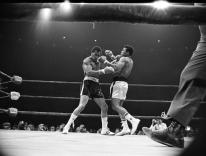"And now I turn you over to the Cuban people," the young woman from the Ministry of Tourism said, gesturing toward Havana’s Plaza of the Revolution where hundreds of thousands waited for Mass to begin. Her words were meant kindly-and, for me, it worked. I had expected our trip, put together in Miami at the last minute, would be a circumscribed experience. We (cardinals, bishops, priests, and lay people) would fly to Havana at 5 a.m., go straight to the Mass, and return immediately after. Our first attempt to land in Havana ended in a scary maneuver. I assured myself: no plane with so much ecclesiastical purple on it could crash.
Tour buses met us, complete with young women in red flight-attendant uniforms. On the brief drive to Havana, we drew alongside a caravan of rickety buses from San Luis. Their passengers held small homemade paper flags. We were soon exchanging peace signs and thumbs up. One of our group wrote "Viva El Papa." Nods and applause.
The altar was five football fields away, and the crowd was enormous. Standing at the edge, I saw many families with children and groups of teen-agers wearing tee shirts that said, "Juan Pablo II: Mensajero De La Verdad La Esperanza." There were no vendors and nothing for sale. I got my flags from an older black man, a self-appointed distributor. Just then, the San Luis bus group arrived carrying yellow balloons and processed toward the front with a little Samba in their steps. I followed. They picked up the rhythm of the chanting crowd, "Juan Pablo our friend, Cuba is with you," and "With the pope, Cuba has hope." The procession dissolved against a wall of people. But a man in a red-and-white striped shirt was skillfully guiding two boys ever forward, so I stuck with them until the crowd became impenetrable. When he saw me try to take a picture, he put his son up on his shoulders, gestured for me to give him the camera, and the boy photographed the crowd and the altar. A woman handed me a pamphlet with the hymns and I joined in the singing. When the pope arrived, the crowd waved the flags wildly, screaming "Christ is present" and "Cuba siempre Católica." I have since read news reports that people were unfamiliar with the Mass. Not at all. Most people sang without referring to the printed words. So many went to Communion that they ran out; the Eucharist was shared.
To a young man in a Florida Marlins baseball cap, I tried in my bad Spanish, "Hernandez, bueno." In English, he replied, "Yes and the Mets have a Cuban too!" He also reported that there had been speculation among Cubans about Fidel’s private meeting with the pope. "Perhaps Fidel has gone to...," he searched for the English. "To forgiveness," he said.
"Esperanza" was the theme of the day, that and a fervent desire for an end to isolation. The pope got one of his biggest cheers when he called for Cuba to open up to the world. These hospitable people certainly seemed ready. By the end of the Mass, I knew the tour guide had done me a great favor in turning me over to the Cuban people.
Please email comments to [email protected] and join the conversation on our Facebook page.
Share
Previous Story
Ancient Warriors
Next Story
Free Riders


